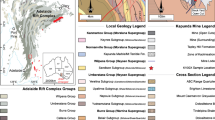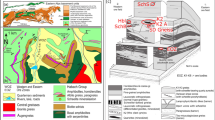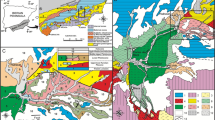Abstract
Mina Primavera, a hematite (Fe2O3) mine located in southern Peru, was exploited beginning approximately 2,000 years ago by two Andean civilizations, the Nasca and Wari. Despite the importance of hematite in the material culture of the ancient Americas, few hematite mines have been reported in the New World literature and none have been reported for the Central Andes. An estimated 3,710 tonnes of hematite were extracted from the mine for over 1,400 years at an average rate of 2.65 tonnes per year, suggesting regular and extensive mining prior to Spanish conquest. The hematite was likely used as a pigment for painting pottery, and the mine demonstrates that iron ores were extracted extensively at an early date in the Americas.
Similar content being viewed by others
References
P.T. Craddock, Early Metal Mining and Production (Washington, D.C.: Smithsonian Institution Press, 1995).
A. Hammel et al., “Pre-Colonial Mining in Southern Africa”, Journal of the South African Institute of Mining and Metallurgy, 100(299), pp. 49–56.
L.H. Robbins et al., “Intensive Mining of Specular Hematite in the Kalahari ca. A.D. 800–1000,” Current Anthropology, 39 (1998), pp. 144–150.
R.A. Dart and P.B. Beaumont, “Evidence of Iron Ore Mining in Southern Africa in Middle Stone Age,” Current Anthropology, 10 (1969), pp. 127–128.
H.N. Lechtman, The Coming of the Age of Iron, ed. T.A. Wertime and J.D. Muhly (New Haven, CT: Yale University Press, 1980), pp. 267–334.
D.A. Scott and W.D. Hyder, “A Study of Some Californian Indian Rock Art Pigments,” Studies in Conservation, 38 (1993), pp. 155–173.
J.M. Erlandson, J.D. Robertson, and C. Descantes, “Geochemical Analysis of Eight Red Ochres from Western North America,” American Antiquity, 64 (1999), pp. 517–526.
M.D. Stafford et al., “Digging for the Color of Life: Paleoindian Red Ochre Mining at the Powars II Site, Platte County, Wyoming, USA,” Geoarchaeology, 18 (2003), pp. 71–90.
G. Petersen, “Minería y Metalurgia en el Antiguo Perú,” Arqueológicas, 12 (1970), pp. 1–140.
E.J.S. Phipps (Department of Art History, Columbia University, 1989).
D.A. Scott, D.A. Doughty, and C.B. Donnan, “Moche Wallpainting Pigments from La Mina, Jequetepeque, Peru,” Studies in Conservation, 43 (1998), pp. 177–182.
K.J. Vaughn et al., Laser Ablation ICP-MS: A New Frontier in Archaeological Characterization Studies, ed. R.J. Speakman and H. Neff (Albuquerque, NM: University of New Mexico Press, 2005), pp. 138–154.
A. Paul, Paracas Ritual Attire: Symbols of Authority in Ancient Peru (Norman, OK: University of Oklahoma Press, 1990).
D.A. Proulx, A Sourcebook of Nasca Ceramic Iconography (Iowa City, IA: Iowa University Press, 2006).
D. Menzel, “Style and Time in the Middle Horizon,” Nawpa Pacha, 2 (1964), pp. 1–106.
K.B. Tankersley et al., “They Have a Rock that Bleeds: Sunrise Red Ochre and Its Early Paleoindian Occurrence at the Hell Gap Site, Wyoming,” Plains Anthropologist, 40 (1995), pp. 185–194.
M. Glowacki, “Food of the Gods or Mere Mortals? Hallucinogenic Spondylus and Its Interpretive Implications for Early Andean Society,” Antiquity, 79 (2005), pp. 257–268.
A.C. Paulsen, “The Thorny Oyster and the Voice of God: Spondylus and Strombus in Andean Prehistory,” American Antiquity, 39 (1974), pp. 597–607.
J. Pillsbury, “The Thorny Oyster and the Origins of Empire: Implications of Recently Uncovered Spondylus Imagery from Chan Chan, Peru,” Latin American Antiquity, 7 (1996), pp. 313–340.
P.J. Reimer et al., “IntCal04 Terrestrial Radiocarbon Age Calibration, 26-0 ka BP,” Radiocarbon, 46 (2004), pp. 1029–1058.
J.W. Eerkens et al., “La Ballena: A Mining Base Camp in the Southern Nasca Region, Peru,” Antiquity Project Gallery, 81(314) (2007).
D.R. Fuller, “The Production of Copper in 6th Century Chile’s Chuquicamata Mine,” JOM, 56(11) (2004), pp. 62–66.
J.B. Bird, Pre-Columbian Metallurgy of South America, ed. E.P. Benson (Washington D.C.: Dumbarton Oaks, 1979), pp. 105–132.
R.L. Burger and Mendieta Matos, “R. Atalla: A Center on the Periphery of the Chavin Horizon,” Latin American Antiquity, 13 (2002), pp. 153–177.
G.D. Fester and J. Cruellas, “Colorantes de Paracas,” Revista del Museo Nacional, 3 (1943), pp. 154–156.
H. Silverman, Cahuachi in the Ancient Nasca World (Iowa City, IA: University of Iowa Press, 1993).
K.J. Vaughn, “Households, Crafts, and Feasting in the Ancient Andes: The Village Context of Early Nasca Craft Consumption,” Latin American Antiquity, 15 (2004), pp. 61–88.
A.L. Kroeber and D. Collier, The Archaeology and Pottery of Nazca, Peru: Alfred L. Kroeber’s 1926 Expedition, ed. P.H. Carmichael and the Field Museum of Natural History) (Walnut Creek, CA: AltaMira Press, 1998).
M.E. Moseley et al., “Burning Down the Brewery: Establishing and Evacuating an Ancient Imperial Colony at Cerro Baúl, Peru,” PNAS, 102 (2005), pp. 17264–17271.
Author information
Authors and Affiliations
Corresponding author
Rights and permissions
About this article
Cite this article
Vaughn, K.J., Grados, M.L., Eerkens, J.W. et al. Hematite mining in the ancient Americas: Mina Primavera, A 2,000 year old Peruvian mine. JOM 59, 16–20 (2007). https://doi.org/10.1007/s11837-007-0145-x
Published:
Issue Date:
DOI: https://doi.org/10.1007/s11837-007-0145-x




